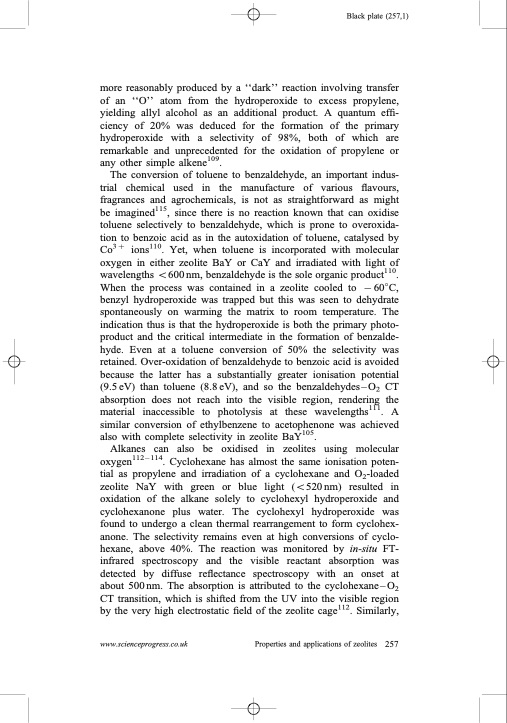
PDF Publication Title:
Text from PDF Page: 035
Black plate (257,1) more reasonably produced by a ‘‘dark’’ reaction involving transfer of an ‘‘O’’ atom from the hydroperoxide to excess propylene, yielding allyl alcohol as an additional product. A quantum effi- ciency of 20% was deduced for the formation of the primary hydroperoxide with a selectivity of 98%, both of which are remarkable and unprecedented for the oxidation of propylene or any other simple alkene109. The conversion of toluene to benzaldehyde, an important indus- trial chemical used in the manufacture of various flavours, fragrances and agrochemicals, is not as straightforward as might be imagined115, since there is no reaction known that can oxidise toluene selectively to benzaldehyde, which is prone to overoxida- tion to benzoic acid as in the autoxidation of toluene, catalysed by Co3þ ions110. Yet, when toluene is incorporated with molecular oxygen in either zeolite BaY or CaY and irradiated with light of wavelengths 5600 nm, benzaldehyde is the sole organic product110. When the process was contained in a zeolite cooled to 60 C, benzyl hydroperoxide was trapped but this was seen to dehydrate spontaneously on warming the matrix to room temperature. The indication thus is that the hydroperoxide is both the primary photo- product and the critical intermediate in the formation of benzalde- hyde. Even at a toluene conversion of 50% the selectivity was retained. Over-oxidation of benzaldehyde to benzoic acid is avoided because the latter has a substantially greater ionisation potential (9.5 eV) than toluene (8.8 eV), and so the benzaldehydes – O2 CT absorption does not reach into the visible region, rendering the material inaccessible to photolysis at these wavelengths111. A similar conversion of ethylbenzene to acetophenone was achieved also with complete selectivity in zeolite BaY105. Alkanes can also be oxidised in zeolites using molecular oxygen112 – 114. Cyclohexane has almost the same ionisation poten- tial as propylene and irradiation of a cyclohexane and O2-loaded zeolite NaY with green or blue light (5520nm) resulted in oxidation of the alkane solely to cyclohexyl hydroperoxide and cyclohexanone plus water. The cyclohexyl hydroperoxide was found to undergo a clean thermal rearrangement to form cyclohex- anone. The selectivity remains even at high conversions of cyclo- hexane, above 40%. The reaction was monitored by in-situ FT- infrared spectroscopy and the visible reactant absorption was detected by diffuse reflectance spectroscopy with an onset at about 500nm. The absorption is attributed to the cyclohexane–O2 CT transition, which is shifted from the UV into the visible region by the very high electrostatic field of the zeolite cage112. Similarly, www.scienceprogress.co.uk Properties and applications of zeolites 257PDF Image | Properties and applications of zeolites

PDF Search Title:
Properties and applications of zeolitesOriginal File Name Searched:
003685010x12800828155007.pdfDIY PDF Search: Google It | Yahoo | Bing
CO2 Organic Rankine Cycle Experimenter Platform The supercritical CO2 phase change system is both a heat pump and organic rankine cycle which can be used for those purposes and as a supercritical extractor for advanced subcritical and supercritical extraction technology. Uses include producing nanoparticles, precious metal CO2 extraction, lithium battery recycling, and other applications... More Info
Heat Pumps CO2 ORC Heat Pump System Platform More Info
| CONTACT TEL: 608-238-6001 Email: greg@infinityturbine.com | RSS | AMP |